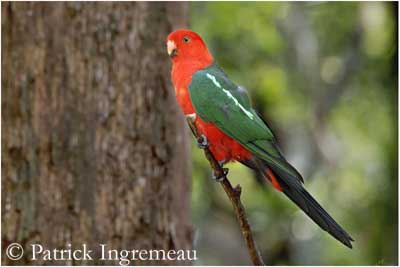
Australian King Parrot
Alisterus scapularis
Psittaciforme Order – Psittaculidae Family
BIOMETRICS:
Length: 41-43 cm
Weight: 195-275gr
LONGEVITY: Up to 25 years
DESCRIPTION:
Australian King-Parrot is the largest king parrot. It is endemic to eastern Australia.
Adult has beautiful bright coloured plumage. It has bright red-orange head, neck and underparts. On the upperparts, back and wings are bright green. Scapulars are pale greenish. Rump, lower back and lower nape are blue. Vent is red, slightly barred with dark green. Tail and undertail feathers are dark bottle green. Central tail feathers are black. Tail is about 20 cm in length. Underwings show blue lesser underwing coverts, and dark bottle green flight feathers.
Male has red upper mandible and grey lower mandible. Tip is black. Eyes are yellow. Legs and feet are grey.
Ang: Australian King Parrot
All : Königssittich
Esp : Papagayo Australiano
Ital : Parrocchetto reale australiano
Nd : Australische Koningsparkiet
Russe : Австралийский королевский попугай
Photos de Patrick Ingremeau
TAMANDUA
Text by Nicole Bouglouan
Sources:
HANDBOOK OF THE BIRDS OF THE WORLD volume 4 by Josep del Hoyo, Andrew Elliot and Jordi Sargatal – LYNX EDICION – ISBN 8487334229
PARROTS OF THE WORLD – An Identification Guide – by Joseph M. Forshaw – Princeton University Press – ISBN 0691092516
Birds in backyards (Birds Australia and Australian Museum)
Wikipedia (Wikipedia, The Free Encyclopedia)

Female resembles male, but she has dull dark green head and uppertail feathers. Throat and breast are green, slightly tinged red on upper throat. Bill is blackish.
Immature resembles female until 6 months of age. Then, male’s head begins to turn red. It has adult plumage at about 16 months, but it needs 14 months more to reach complete adult plumage. It can mate when it is about 3 years old. Female reaches its sexual maturity at one year.
There is one subspecies, with different size, but similar in appearance, Alisterus scapularis minor, which is smaller (about 5 cm shorter) and lives in north-eastern Australia.
VOICE: SOUNDS BY XENO-CANTO
Australian King-Parrot utters a shrill “crassak-crassak…crassak-crassak” in flight. Alarm call is a harsh, metallic shriek. Perched male gives high-pitched “pwee-eet…pwee-eet”. Female is silent, but she may utter occasional guttural cackling sounds.
HABITAT:
Australian King-Parrot is found in moist, dense forests, eucalyptus wooded areas, rainforests, but it also frequents suburban parks and gardens, and farmlands. It can live in mountain forests up to 1600m, but mostly below 1000 metres.
RANGE:
Australian King-Parrot lives from north and central Queensland to southern Victoria.
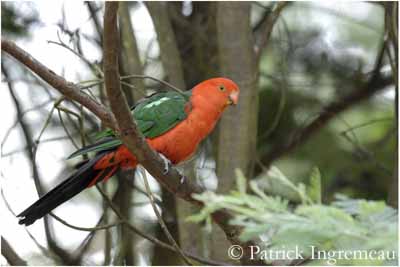
BEHAVIOUR:
Australian King-Parrot feeds mainly in trees. It is mostly arboreal, and comes down to the ground for drinking and feeding on fallen seeds. This parrot is less noisy or active than other species. It can cause damage in orchards when they feed in flock. They feed silently into vegetation. If it is disturbed, it flies off through the forest.
Australian King-Parrot is often seen in pairs or small flocks.
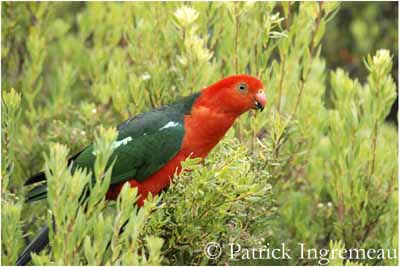
During breeding season, male performs some displays. It stretches its body, tightens its body plumage, but it ruffs its head feathers. Then, it shakes or flicks its wings in order to display the light green barring. During these displays, it utters harsh calls, and contracts its pupils to accentuate the yellow iris. Female responds in the same way, bobbing her head and begging food. Male usually regurgitates food to her. Pairs mate for life.
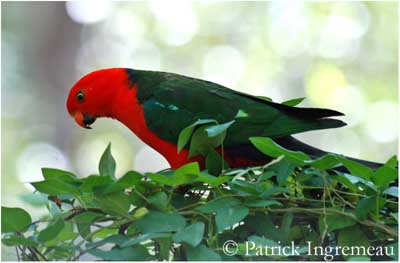
Australian King-Parrot is mainly sedentary, but southern birds make local altitudinal movements, from highlands to nearby lowlands in winter.
FLIGHT:
Australian King-Parrot performs direct flight with deep, rhythmic wing beats. When it is flying through treetops, it often makes sharp turns by tilting the body, and partially fanning its tail for alighting.
REPRODUCTION:
Australian King-Parrot breeds from August to January, but it depends on the locality. It nests in dense forest, in hollow in tree, particularly in Eucalyptus trunk. Hollow can be very deep, with entrance at up to 10 metres above the ground, but with eggs laid near ground-level. Nest is usually lined with decayed wood dust and chewed wood shavings.
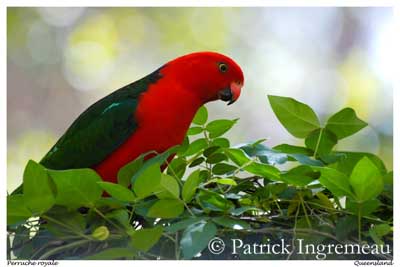
Female lays 4 to 6 slightly glossy eggs. Incubation lasts about 20 days, by female alone. But male attends her during this period. Both parents feed altricial chicks, and young fledge at about 5 weeks of age.
At the end of breeding season, family groups disperse, and immature gather in flocks of up to 30 birds or more, which can damage orchards and crops.
DIET:
Australian King-Parrot feeds on nuts and seeds, particularly of Eucalyptus and Acacias, but also of great variety of plants. It also consumes fruits and berries, nectar, blossoms and leaf buds, insects and their larvae.
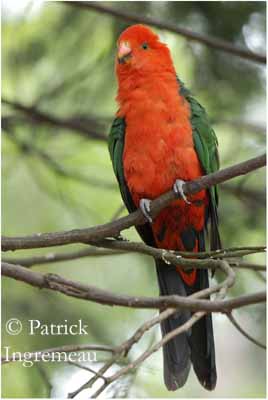
PROTECTION / THREATS / STATUS:
Australian King-Parrot populations are stable or increasing recently, probably because food is available in mature gardens, and birds can survive the winter. People also provide food for them.
Australian King-parrot is also appreciated as pet, but it has limited “talking”.